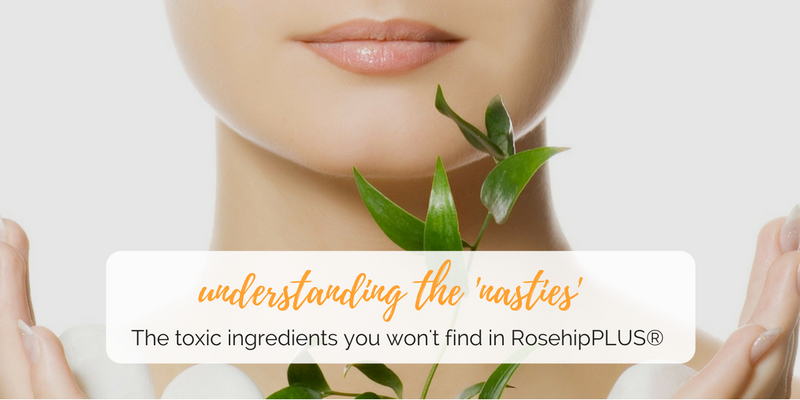

By Lisa Mclean
You may have seen us reference “No Nasties” when we talk about our RosehipPLUS products, as do many other brands – But when a product or brand claims to have no nasties, what does that actually mean?
We know that ‘nasties’ refer to what we don’t want in our skincare, but what exactly are these ‘nasties’ and what are the issues with them? Below we explain the main ‘nasty’ ingredients we don’t have in our products and why…
PARABENS & SYNTHETIC PRESERVATIVES
Parabens are the most commonly used synthetic preservative used in beauty products. They are derived from petrochemicals, work as anti-bacterial agents and are added to our beauty products to prevent spoilage and extend their shelf life. Parabens easily penetrate through the skin, and one the biggest concerns surrounding having parabens in cosmetics is how they can mimic oestrogen in our body.
Parabens have been detected in human breast cancer tissues, suggesting that there is a possible association between cosmetics and cancer. Oestrogen mimicking is particularly a concern for teenagers with the question around whether parabens in products has resulted in the increasing incidence of early puberty in girls. The other concern raised around Parabens is how they react with UVB in sunscreen, which can lead to DNA damage and increased skin aging.
The most common parabens to look out for on product labels are methylparaben, butylparaben, ethylparabenand and propylparaben, along with any ingredient with the “paraben” in their names. Other preservatives to look out for and avoid are benzoic acid, hydroxyl benzoic acid, hydroxybenzoate and phenoxyethanol.
SULPHATES
One of the most common type of sulphates you see referenced on beauty products are Sodium Lauryl Sulphate also known as SLS and SLES. However, this is just one of many types of sulphates that can be found in cosmetics. Sulphates are a surfactant, which means they help bind oil and water to help lift dirt from the body which we then wash away with water. They are also the reason why body washes and shampoos have the ability to lather. As you can imagine they are used in a lot of soap products or anything that foams such as face cleansers and make-up removers. Sulphates can be derived from natural sources such as coconut oil or palm kernel oil or made synthetically with petroleum-derived chemicals.
There are a few issues with sulphates. Firstly, they can cause skin and eye irritations, particularly those with eczema and sensitive skin. SLS used in beauty products may be contaminated with 1,4-dioxane or ethylene oxide – these are known as human carcinogens or cancer causing substances. There has been many assessments made on the safety of sulphates and the Cosmetic Ingredient Review came to conclusion that as long as the product does not stay on the skin (therefore needs to be washed off) it could be used safely in beauty products if the concentration is under 1%. However, the other issue with sulphates is how they dry out your skin and hair, stripping them of their natural oils and allowing other chemicals to be easily absorbed. Sulphate free products are gentler on the skin and don’t strip the skin of its natural oils.
PETRO CHEMICALS & SYNTHETIC FRAGRANCES
Petro chemicals are synthetic and obtained from petroleum and natural gas. Almost all mainstream cosmetics contain synthetic ingredients including synthetic fragrances, made from petro chemicals. There have been many studies on the toxicity to humans since they are absorbed directly into the blood stream from the skin.
One particularly concerning group of petrochemical are Phthalates, which are used as plasticisers and solvents. They have been found to disrupt the endocrine system and have been linked with endometriosis and early puberty in girls, as well as reproductive organ abnormalities and reduced fertility in males. They have also been seen to act on the thyroid and linked with obesity.
In light of these concerns, several phthalates have been banned for use in cosmetics in Australia: dibutylphthalate, diethylhexylphthalate, diisobutylphthalate and di(methyloxyhexyl)phthalate. Some other toxic ingredients under this category to avoid include Coal Tar, DEA/TEA/MEA, Ethoxylated Surfactants, 1.4-dioxane, Formaldehyde, Mineral Oil, Oxybenzone, Hydroquinone, PPD (Paphenylenediamine), PEG (Polyethylene Glycol) and Toluene.
Fragrance/parfum is a particularly questionable ingredient in beauty products if it’s not from a natural source as it may hide a variety of different toxic chemicals.
ARTIFICAL COLOURS
Just like in our food, artificial colours are used in beauty products so they are more visually appealing. The problem with artificial colours is that they are usually made from coal tar or petroleum and they can be contaminated with heavy metals. Your skin can absorb these metals, which may cause irritations or other health issues. Certain colours likes blues and reds have been looked at in studies linking them to cancer, and other colours can cause allergies and behavioural issues. Really there is no need for beauty brands to use artificial colours when you can use natural pigments from plants, clays and herbs. When looking at ingredient labels be wary of words like “colourant”, CI 26100, F&DC 6, Red 1, Blue 3 and Yellow 6.
REFERENCES
http://davidsuzuki.org/issues/health/science/toxics/chemicals-in-your-cosmetics—sodium-laureth-sulfate/
http://davidsuzuki.org/issues/health/science/toxics/chemicals-in-your-cosmetics—parabens/
http://www.petrochemicalfreeliving.com/petrochemicals-skincare-makeup/
https://www.choice.com.au/health-and-body/beauty-and-personal-care/skin-care-and-cosmetics/articles/chemicals-in-cosmetics
« Previous post | Next post »

Follow Us On Instagram
No images found!Try some other hashtag or username


